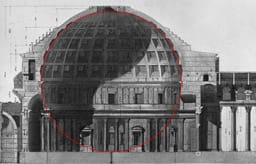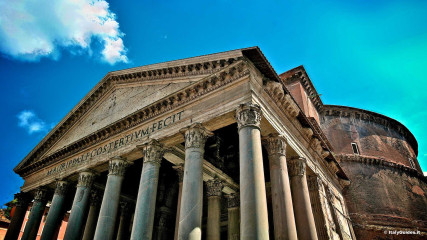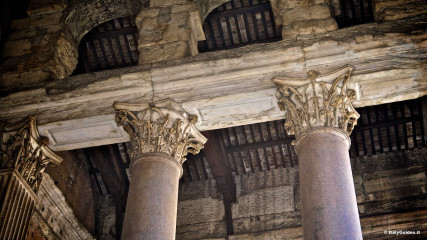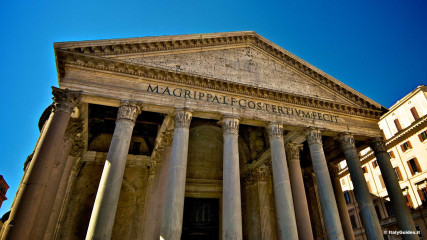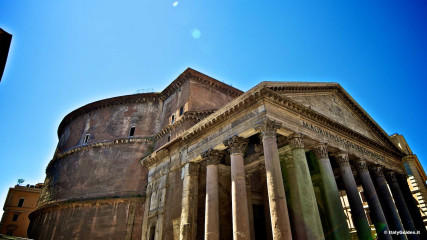The Roman Pantheon is the monument with the greatest number of records: the best preserved, with the biggest brick dome in the history of architecture and is considered the forerunner of all modern places of worship. It is the most copied and imitated of all ancient works.
Michelangelo felt it was the work of angels, not men.
Where it stands was not chosen by chance, but is a legendary place in the city’s history. According to Roman legend, it is the place where the founder of Rome, Romulus, at his death was seized by an eagle and taken off into the skies with the Gods.
But what was it for and what does the name mean?
The name comes from two Greek words pan, “everything” and theon, “divine”. Originally, the Pantheon was a small temple dedicated to all Roman gods. Built between 25 and 27 B.C. by the consul Agrippa, Prefect of the Emperor Augustus, the present building is the result of subsequent, heavy restructuring. Domitian, in 80 A.D., rebuilt it after a fire; thirty years later it was hit by lightening and caught fire again.
It was then rebuilt in its present shape by the Emperor Hadrian; under his reign, Rome reached its maximum splendour and the present structure is probably the fruit of his eclectic genius and exotic tastes. In fact, the Pantheon combines a clearly Roman, cylindrical structure with the splendid outer colonnade of Greek inspiration.
Although the new structure was very different from the original, Hadrian wanted a Latin inscription on the façade, that translated means: “It was built by Marcus Agrippa, son of Lucius, consul for the third time”.
What is extraordinary about the Pantheon is not only its architecture or external beauty, but also the fact that it represents a true cultural revolution. It was the first temple built for the common people. Today, this could seem an obvious concept, but in ancient times temples were forbidden places, only for vestals and priests.
The term temple comes from the Latin templum, which means “delimited space”; inside was sacred and with often just enough space for a sacrificial altar or a brazier for divine fire; temples were conceived to be beautiful and imposing outside and everyone was denied access; the penalty for access was death.
The Pantheon overturns this concept and for the first time the idea of a place of worship open to everyone was conceived, where the faithful could spiritually communicate with the Gods.
To enter, we cross the pronaos with its imposing granite column forest. There are sixteen, monoliths, more than 14 metres high, some grey others in pink granite from Aswan, the latter brought from ancient Egypt by transport that would be considered exceptional even today. The Bronze door at the end of the columns is just as impressive in size, 7 metres high, a real record for the times.
On entering the door, the effect you feel is meant to be overwhelming. You suddenly find yourself in this huge empty space which causes vertigo and makes you feel tiny. This is how you were supposed to feel in front of the Gods.
The space is a perfect sphere symbolising the vault of heaven; the height of the dome is the same as its diameter creating perfect balance and unique harmony; it is round so as to place all Gods at the same level of importance.
Surrounding you, placed in seven splendid niches between two Corinthian columns there used to be the seven gods linked to the worship of planets, or considered to be such: the Sun, the Moon, Venus, Saturn, Jupiter, Mercury and Mars. And with the advent of Christianity, some of them were used for small altars dedicated to Christian martyrs.
The Pantheon’s greatness mainly comes from its mighty dome, still today the biggest brick dome ever built. Raising it using bricks alone would have been impossible; the ceiling would not have withstood the weight and would have collapsed. As the Romans had no reinforced concrete they found another solution.
This dome was built with a single casting of concrete in subsequent layers. The concrete was lightened by mixing it with lighter stones as it neared the highest point. Initially mixing the concrete with heavy travertine stone, going upwards using progressively lighter materials; like tuffo stone. The top layer was made with pumice, a light-weight stone.
At the centre of the dome, there is a 9 metre diameter hole, the Oculus. A brilliant idea. The Pantheon has no windows and the only light penetrates from above streaming down like a river of inner light; towards midday, the rays coming through the Oculus are particularly intense.
The belief that the Oculus was built so that the rain could not get in is not true, when it rains, it also rains in the Pantheon; the floor is slightly convex so the water flows away thanks to an effective drainage system.
In the VII century, the Pantheon was turned into a church dedicated to Mary and the Martyrs, a fact that guaranteed, at least partially, its preservation. In the XVI century, Pope Urban VIII, from the princely Barberini family, decided to remove all the bronze covering from the pronaos ceiling and to use it for other purposes: one part was used to forge 80 canons for the papal fortress of Castle Sant’Angelo; the rest was used for a real masterpiece.
This remaining part was used by Bernini to create the splendid baldacchino or canopy of St Peter’s which stand over the papal altar in the centre of the Basilica.
This episode, together with the various thefts of building material that occurred in those years to monuments of ancient Rome, consigned the Barberini family to history with the famous saying: “What the barbarians didn’t do to Rome the Barberini did!”.
During the same period, by the Pope’s wishes, Bernini tried to highlight the clerical character of the structure by creating two bell towers at the sides of the pronaos, nicknamed by the Romans “ass’s ears”; they were eliminated in the XIX century.
However, everything you see has not changed much in two thousand years. The columns, the marble, the inner decorations have not changed; even the floor is the same, built with precious marble from all over the Mediterranean. Here walked emperors like Hadrian and Charles V. The Pantheon is also a national Mausoleum; it is the resting place of the Italian Royal family and some great Renaissance artists including Raphael.
Yet again the Roman Pantheon is the forerunner of several other famous buildings, like that of the same name in Paris or Westminster Abbey.
Today, the square with this ancient masterpiece “Piazza della Rotonda” is one of the most popular places in the city. It was built during the papacy of Clement XI by knocking down several buildings.
Over the centuries, the Pantheon in Rome has been ransacked, closed, used as a fortress and as a church. It has suffered earthquakes and floods, but has survived the centuries intact and today, after more than two thousand years, it is still the bewitching backdrop to the walks of Romans and tourists.







